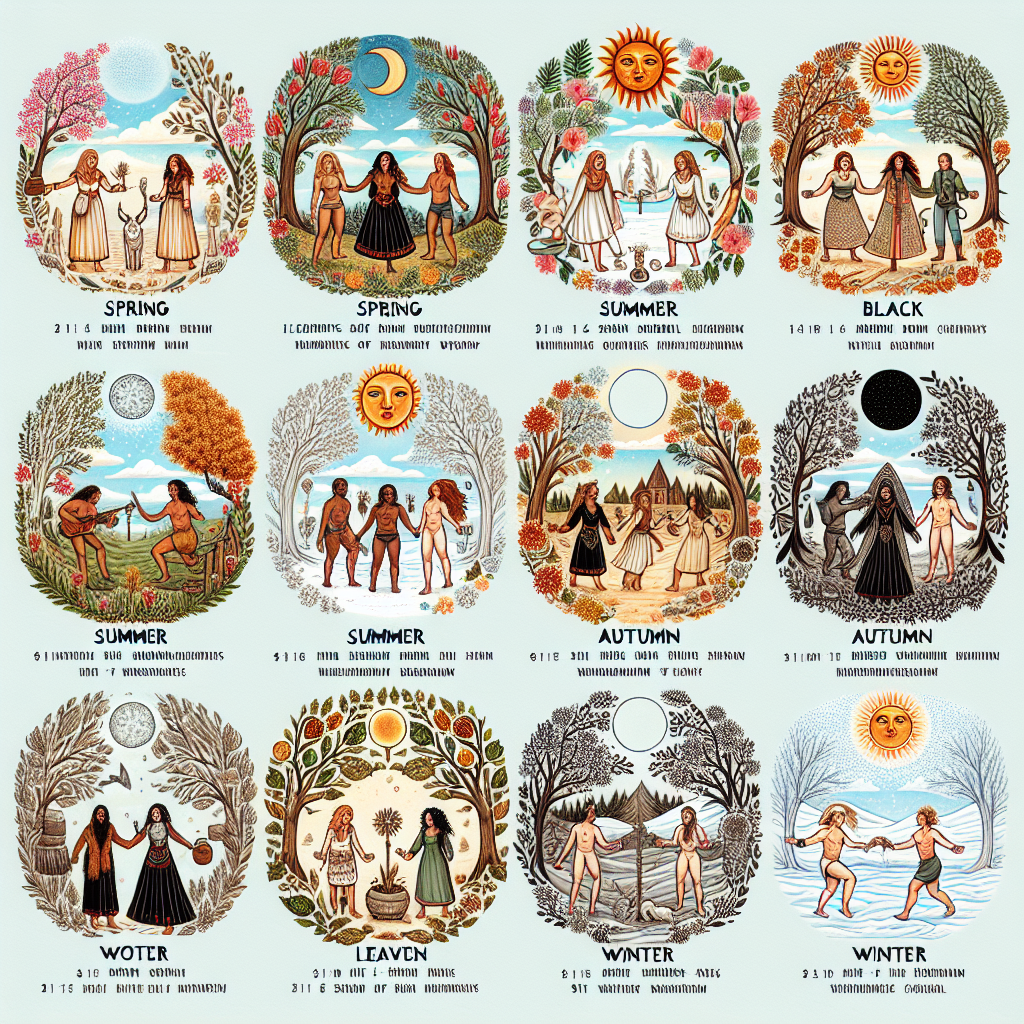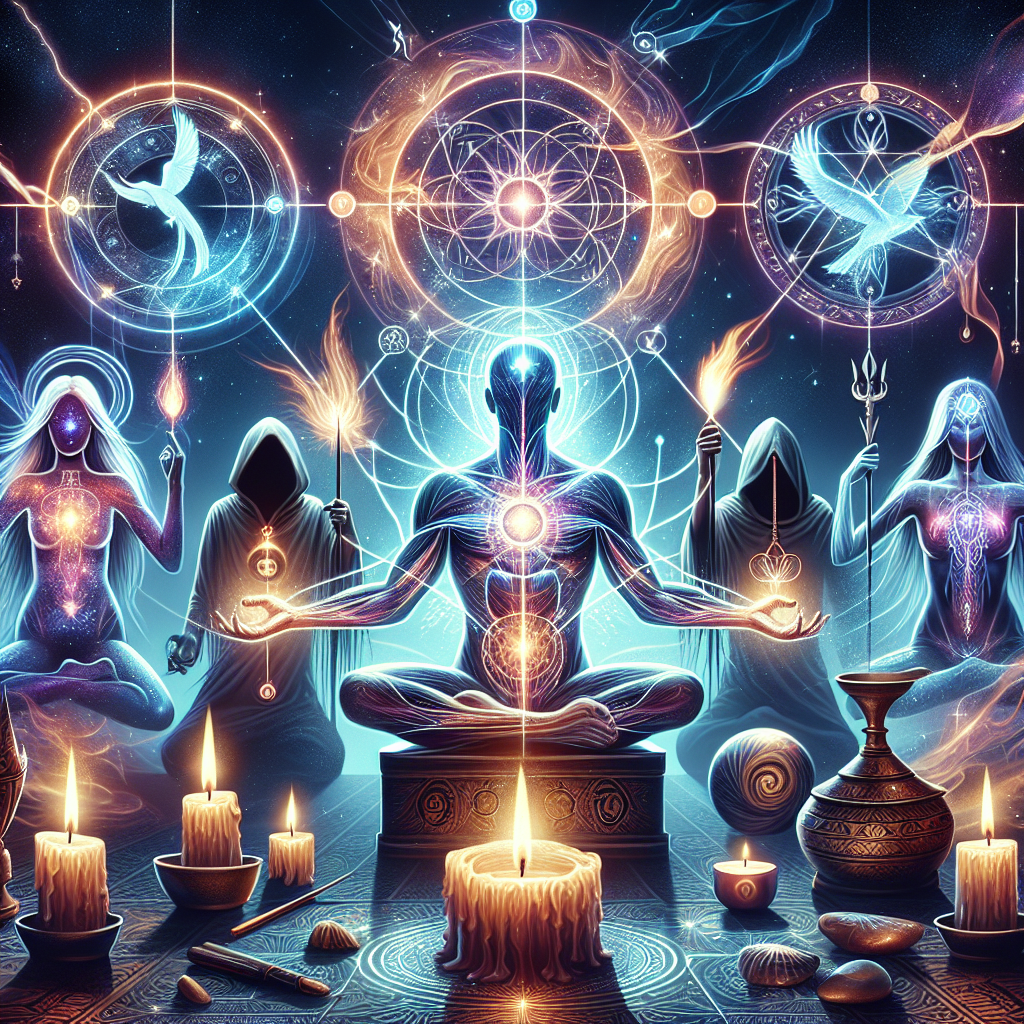As an Amazon Associate I earn from qualifying purchases.

u003cH2u003eIntroduction to Norse Pagan Seasonal Ritualsu003c/H2u003e
u003cH3u003eHistorical Backgroundu003c/H3u003e
In Norse Paganism, the cycle of the year is deeply intertwined with nature, and various rituals are conducted to align with seasonal changes. These practices are rooted in ancient Germanic traditions and have remained significant through the ages, particularly among modern practitioners who seek to reconnect with nature and ancestral wisdom. Today, with a rising interest in Pagan and heathen practices, these rituals provide a means of spiritual engagement and cultural preservation.
u003cH3u003eCurrent Significanceu003c/H3u003e
Norse Pagan communities observe 16 key rituals that correspond to the shifts in seasons, reflecting an intimate relationship between the deities, nature, and the cyclical flow of time. These rituals serve not only as a means of honoring the gods but also as a way for individuals to find balance and harmony in their lives. As people increasingly look for ways to live sustainably and with greater mindfulness, these ancient practices offer a compelling path.
u003cH3u003eEngaging Elementsu003c/H3u003e
A compelling statistic reveals that participation in Norse Pagan rituals has surged by nearly 40% in recent years within certain communities. Practitioners often report a greater sense of well-being and connection to the earth. For those feeling disconnected from modern, fast-paced lifestyles, engaging in these rituals offers a potential solution for deeper spiritual fulfillment.
u003cH2u003eDetails of the 16 Seasonal Ritualsu003c/H2u003e
u003cH3u003eSpring Equinox (Ostara) and Summer Solstice (Litha)u003c/H3u003e
The Spring Equinox, also known as Ostara, celebrates the return of fertility and balance in nature. Rituals during this time often involve the lighting of bonfires, decorating with flowers, and invoking deities associated with rebirth and renewal. The Summer Solstice, or Litha, marks the longest day of the year and involves feasting, dancing, and ceremonies held at sacred sites to honor the sun’s power.
u003cH3u003eAutumn Equinox (Mabon) and Winter Solstice (Yule)u003c/H3u003e
Mabon, the Autumn Equinox, is a time for giving thanks for the harvest and reflecting on the coming winter. Rituals may include offering the first fruits of the harvest to the gods and performing acts of service. Yule, the Winter Solstice, celebrates the rebirth of the sun and the hope of renewal. Customs involve the burning of the Yule log, decorating with evergreens, and holding vigils to welcome the returning light.
u003cH3u003eOther Seasonal Celebrationsu003c/H3u003e
In addition to the equinoxes and solstices, Norse Paganism observes other significant seasonal markers such as Imbolc, Beltane, Lughnasadh, and Samhain. Each of these rituals corresponds with specific points in the agricultural calendar and involves various practices such as purification rites during Imbolc, fertility dances during Beltane, communal feasts at Lughnasadh, and honoring the ancestors at Samhain.
u003cH3u003eMonthly Celebrations: Full Moon Ritualsu003c/H3u003e
Another series of rituals in Norse Paganism involves monthly celebrations that align with the phases of the moon, particularly the full moon. These rituals often focus on personal reflection, magical workings, and invoking lunar deities. Full moon ceremonies can also include activities such as rune casting, meditation, and crafting talismans to harness lunar energy.
u003cH2u003eCultural and Practical Impactu003c/H2u003e
u003cH3u003ePreserving Ancestral Wisdomu003c/H3u003e
These 16 rituals not only immerse practitioners in seasonal rhythms but also serve as a conduit for preserving and transmitting ancestral wisdom. Modern-day Norse Pagans often see themselves as part of a long, unbroken chain of tradition-keepers, and these practices help bridge the gap between past and present.
u003cH3u003eEnhancing Community Bondsu003c/H3u003e
Communal rituals strengthen the bonds among Norse Pagan practitioners by fostering a shared sense of purpose and belonging. Whether it’s the collective joy of a solstice celebration or the reflective time spent during a Samhain rite, these activities build community and enhance mutual support.
u003cH3u003eEcological Consciousnessu003c/H3u003e
Adhering to these rituals fosters a stronger ecological consciousness. Participants often engage in eco-friendly activities such as planting trees, cleaning natural spaces, and adopting sustainable practices. This alignment with the natural world encourages a holistic and environmentally responsible lifestyle.
1. **Dísablót (late winter/early spring):** Celebrated to honor the dísir, female spirits associated with fertility and family. This ritual involves offerings of mead or food to these spirits to seek protection and prosperity for the coming year. Engaging in energy alignment with nature’s cycle of rebirth enhances the effectiveness of these spiritual rituals.
2. **Ostara (spring equinox):** Celebrated around March 21st, Ostara honors the goddess Eostre and the balance between day and night. Norse pagans often perform energy work during this time, focusing on planting seeds of intention for personal growth. Rituals might include decorating eggs, planting new plants, and lighting candles to signify new beginnings and personal power.
3. **Walpurgisnacht (April 30th):** This festival honors the transition from spring to summer and includes bonfires to ward off evil spirits. The magick practices during this night involve invoking Freyr and Freyja for blessings of fertility and protection. Drumming and chanting can be used to heighten the ritual’s energy alignment with the season.
4. **Beltane (May 1st):** Known as a fire festival, Beltane focuses on life, fertility, and the blossoming of nature. Ritual fires are kindled, and celebrants might weave floral garlands or dance around the Maypole. Spiritual rituals during Beltane revolve around invoking the earth’s energies to boost creativity and passion.
5. **Midsummer (summer solstice):** Celebrated around June 21st, this festival honors the sun at its peak. Rituals include lighting bonfires, leaping over fires to cleanse and purify, and offerings to the sun god, Sol. Energy work during Midsummer focuses on maximizing personal power and harnessing the sun’s energy.
6. **Lammas (August 1st):** Also known as Hlæfmæsse, Lammas marks the start of the harvest season. Offerings of the first harvested grains are made to deities like Freyr to ensure continued prosperity. Ritual bread baking and sharing symbolically ties the community together, reinforcing energy alignment with the season’s cycle of giving.
7. **Autumn Equinox (September 21st):** Also called Haustblót in Norse traditions, this festival honors the gods for the harvest and seeks balance as day and night are equal. Offerings of mead and food to gods like Thor and Freyja express gratitude. Spiritual rituals often include crafting corn dolls and reflecting on the year’s achievements and lessons.
8. **Winternights (late October):** Celebrated to mark the end of the harvest and the beginning of winter, Winternights is dedicated to honoring ancestors and the land spirits. Rituals include feasting, storytelling, and making offerings to the dead. Energy alignment involves connecting with the spiritual energies of the ancestors for guidance and protection.
9. **Yule (winter solstice):** Yule spans several days around December 21st, celebrating the rebirth of the sun and honoring Odin and other gods. Rituals might include decorating Yule trees, candle lighting, and the burning of the Yule log. Magick practices focus on setting intentions for the new year and drawing on the sun’s reborn energy.
10. **Thorrablot (mid-winter):** This festival venerates Thor and the power needed to endure the harshest part of winter. Ritual feasts often featuring traditional foods like fermented shark or ram’s testicles. Spiritual rituals may involve storytelling and invoking Thor’s strength for protection during this period.
11. **Einherjar Feast (November 11th):** This day honors the fallen warriors who reside in Valhalla. Feasts and toasts are made to the brave ancestors. Energy work during this time involves honoring one’s own inner warrior spirit and strengthening personal resolve.
12. **Charming of the Plow (early February):** This festival marks the start of the agricultural year. Blessing the plow and farm tools through rituals ensures a bountiful planting season. Participants may perform energy alignment practices to harmonize with the land they intend to cultivate.
13. **Sigrblot (late April):** A victory celebration in anticipation of the coming summer months. Offerings to Odin and Freyr seek blessings for success in endeavors. Rituals might include symbolic battles and re-enactments, channeling energy work for strategic planning and victory.
14. **Alfarblót (late autumn):** This private festival honors the elves or land spirits (alfar). It involves household-specific offerings and rituals, emphasizing the importance of privacy and intent. Personal power in this ritual lies in cultivating a deep relationship with local land spirits.
15. **Horning (mid-February):** Celebrated for feasting and horn-blowing to strengthen communal bonds. The ritual amplifies collective energy alignment during a time when winter’s imprisonment weighs heavily, bolstering community spirit.
16. **Huginn and Muninn Blót (variable):** Rituals that honor Odin’s ravens, Huginn (Thought) and Muninn (Memory), focusing on wisdom and introspection. Magick practices during this blót center on gaining insights and harnessing mental clarity through meditation and offerings.
Statistics indicate that as of 2021, modern Norse Paganism, or Heathenry, has seen a significant rise, with nearly 10,000 practitioners in the United States alone, a testament to the growing interest in these ancient but profoundly resonant spiritual practices.
Yule Celebrations
Celebrating Yule has always been a significant part of my family traditions. We prepare a Yule log, decorate it with runes, and burn it in a ceremonial fire. The warmth of the fire amid the cold winter nights provides a sense of comfort and connection with our ancestors. Sharing stories around the Yule log helps reinforce our bonds and keeps the spirit of tradition alive.
During Yule, we also engage in a series of gift exchanges. These are not just material offerings, but also include handmade crafts and foods that we’ve prepared throughout the year. The idea of giving and receiving creates a circle of appreciation and acknowledges that everyone has something valuable to contribute. It’s a way to express our gratitude and strengthen our community.
As part of the Yule rituals, we observe a night vigil to honor the return of the light. Staying awake through the longest night of the year, we meditate, read poetry, and sing songs that evoke the essence of the season. This practice is not only a tribute to the sun’s return but also a chance for introspection and renewal.
Ostara Observances
Ostara, the spring equinox, brings a sense of renewal and awakening. We celebrate by engaging in outdoor activities, such as planting seeds and taking nature walks. These actions symbolize the growth and fertility that comes with spring. The act of planting seeds also serves as a metaphor for setting new intentions and goals for the coming year.
Another ritual we practice during Ostara is the decoration of eggs. Each family member paints or dyes eggs with specific symbols and colors that represent their personal wishes and aspirations. These eggs are then hidden in the garden for a fun egg hunt. The discovery of the eggs is accompanied by laughter and joy, symbolizing the abundance and surprises life can bring.
In the evening, we gather around a bonfire to sing and dance, celebrating the balance of day and night. This is a time for conviviality and connecting with our community. We share a feast composed of seasonal foods, emphasizing the theme of renewal and growth. Eating together not only nourishes our bodies but also strengthens the communal bonds that are so vital in Norse Paganism.
Summer Solstice Festivals
The summer solstice, or Midsummer, is a time of celebration and invoking the sun’s energy. We create flower crowns made from local blossoms, which is both a creative and a communal activity. Wearing the crowns during the festivities symbolizes our connection with nature and the divine.
We also set up a maypole and engage in traditional dances around it. The movements and songs are passed down through generations, creating a continuity that ties us to our forebears. Dancing around the maypole is more than just physical activity; it’s a joyous expression of life, prosperity, and community.
During Midsummer night, we light bonfires and stay up until dawn. These fires are believed to protect us against evil spirits and to bring good fortune. We often jump over the bonfire as a way to symbolize purification and to ensure health and happiness for the rest of the year. The entire night is filled with storytelling, music, and an overwhelming sense of unity and joy.
Samhain Rituals
Samhain, marking the end of the harvest and the onset of winter, is a deeply spiritual time. Our rituals begin with a meal where we set a place for loved ones who have passed away, inviting them to join us in spirit. This act honors their memories and acknowledges their continued presence in our lives.
We also engage in divination practices during Samhain. Using runes, tarot cards, or scrying, we seek guidance and insight into the year ahead. These practices are performed with the utmost respect and reverence, knowing that the veil between worlds is thin at this time. The insights gained help us make informed decisions and prepare for the months ahead.
On the night of Samhain, we walk through the garden and fields with lanterns, illuminating the path as a way of guiding spirits back to their resting places. This ritual underscores the cyclical nature of life and death, reminding us to respect the land and those who have come before us. The feeling of connection to both the physical and spiritual realms is profoundly impactful and humbling.
u003ch2u003e1. What is the purpose of aligning with the seasons in Norse Paganism?u003c/h2u003e
u003cpu003eAligning with the seasons in Norse Paganism helps practitioners harmonize their energy with the natural cycles of the earth. This alignment enhances spiritual connection, supports personal growth, and fosters a deeper understanding of nature’s processes and power.u003c/pu003e
u003ch2u003e2. How do seasonal rituals affect my personal power?u003c/h2u003e
u003cpu003eSeasonal rituals can amplify your personal power by synchronizing your energy with the earth’s rhythms. This alignment enables you to draw strength from the natural world, thereby enhancing your inner vitality, intuition, and spiritual abilities.u003c/pu003e
u003ch2u003e3. Are there specific deities to focus on for each season?u003c/h2u003e
u003cpu003eYes, Norse Paganism honors different deities associated with various seasons. For example, Thor is often celebrated for his protective energy during stormy weather, while Freyr, associated with fertility and prosperity, is honored during the spring.u003c/pu003e
u003ch2u003e4. Can these rituals help with energy alignment in daily life?u003c/h2u003e
u003cpu003eAbsolutely. Regularly practicing seasonal rituals can help you attune to the natural ebb and flow of energies, making it easier to maintain balanced energy in your daily life. This can lead to improved focus, emotional stability, and overall well-being.u003c/pu003e
u003ch2u003e5. What types of magick practices are common in Norse Pagan seasonal rituals?u003c/h2u003e
u003cpu003eCommon magick practices include invoking deities, using runes, performing blot (sacred offerings), and crafting symbols or talismans. Each season may call for specific practices that resonate with its energy and themes.u003c/pu003e
u003ch2u003e6. How do I prepare for a seasonal ritual?u003c/h2u003e
u003cpu003ePreparation involves researching the significance of the upcoming season, gathering necessary tools or offerings, and finding a suitable ritual space. You may also meditate to clear your mind and set intentions for the ritual.u003c/pu003e
u003ch2u003e7. Do I need to follow specific guidelines for each ritual?u003c/h2u003e
u003cpu003eWhile certain traditions offer guidelines, Norse Paganism is flexible, allowing personal interpretation. It’s important to focus on your personal connection to the ritual’s purpose and adjust practices to resonate with your spiritual journey.u003c/pu003e
u003ch2u003e8. How can I incorporate energy work into these rituals?u003c/h2u003e
u003cpu003eIncorporate energy work by focusing on breathing exercises, visualizing energy flows, and using hand movements or gestures to channel energy. Reiki or other energy healing techniques can be adapted to align with the ritual’s theme.u003c/pu003e
u003ch2u003e9. Are there any specific tools that are essential for these rituals?u003c/h2u003e
u003cpu003eEssential tools vary but commonly include runes, mead or ale for offerings, candles, and symbols associated with specific deities or natural elements. These tools help focus your intention and facilitate a deeper connection with the ritual.u003c/pu003e
u003ch2u003e10. How do I measure the effectiveness of my seasonal rituals?u003c/h2u003e
u003cpu003eEffectiveness can be measured by your sense of connection, alignment, and inner peace after the ritual. Journaling about your experiences and any signs or synchronicities you notice can also help you gauge the ritual’s impact on your spiritual journey.u003c/pu003e

## Conclusion
Embracing energy alignment through Norse Paganism’s seasonal rituals enables adherents to harmonize with natural cycles, fostering greater spiritual awareness and personal power. Rituals intricately tied to the seasons, such as the use of symbolic artifacts and offerings to deities, help practitioners connect profoundly with the energies of earth, water, air, and fire. Celebrating the solstices and equinoxes, for example, not only honors pivotal moments in the solar cycle but also amplifies one’s attunement to the natural rhythms, enhancing spiritual insight and personal transformation.
Engaging in magick practices and energy work rooted in Norse traditions elevates one’s ability to manifest intentions and protect against negative energies. Seasonal rituals reinforce the themes of growth, renewal, and release appropriate to each time of year, facilitating a deeper connection to one’s inner strength and intuition. Practices like rune casting, meditation, and ceremonial offerings enable practitioners to channel divine energies, resulting in a balanced flow that nurtures both the mind and spirit. Through these 16 meticulously crafted rituals, individuals can realign with ancient wisdom, fostering a sacred bond with the seasons and empowering their spiritual journey.
Amazon and the Amazon logo are trademarks of Amazon.com, Inc, or its affiliates.


